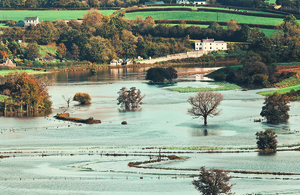Flood Forecasting Centre: supporting decision making
The Flood Forecasting Centre's role in government flood response.

Role in briefing government and local authorities
The Flood Forecasting Centre (FFC) regularly briefs the civil service, government departments and ministers. This is to help local authorities and the national government make decisions about the nation’s resources and flood response. The government can then make vital decisions to ensure that the nation can cope with a sustained flood alert.
How FFC guidance is used
It is important for authorities to understand the likelihood of a flood event and the consequences it could have. An example is flood prediction on the east coast. The port of Immingham in Lincolnshire contains large amounts of salt. Six months’ worth of the UK’s road grit supply is stored here. If a tidal surge were to hit the east coast, the depot would become flooded. This would ruin the road salt forever. If we then experienced a cold winter, the nation’s roads could well become impassable.
Strategy and operations
The Flood Forecasting Centre fulfils 2 main roles for government flood response. The first is strategic. Twice a year the FFC reports to resilience networks which are hosted at the Cabinet Office. These briefings are held to ensure that the government has the resources in place to cope with any major event throughout the year. The FFC briefs the meeting on the general picture for both the winter and the summer. This helps the authorities to take any steps before an event occurs.
The second role of the FFC is its operational input into government. This consists of advising what actions to take once a flood is about to happen or already happening. The FFC issues daily Flood Guidance Statements (FGS) that provide a 5-day lead time for events. The centre also produces Flood Outlooks that cover the next 30 days. When the flood risk increases, the FFC provides information to help with the nation’s response. To do that the FFC reports into the National Flood Advisory Service (NFAS) at the Department for Environment, Food and Rural Affairs (Defra).
Lead government departments are then made aware of a potential flood event. Depending on the level of threat, the team may decide to a call a Cabinet Office Briefings Room (COBR) meeting. This brings key people together into one room to coordinate response.
There are 3 levels of COBR:
- Official – led by the Civil Service
- Ministerial – led by government departments
- Prime Ministerial
When the Somerset levels experienced major flooding in 2013, COBR’s were held every day. The FFC were responsible for ensuring that everybody in the room was kept updated on the current situation and the forecast. This enabled authorities to respond in the most effective way.
COBRs tend to take place in the Cabinet Office Briefing Rooms in Westminster but they can also happen remotely. In the winter 2013 floods, the FFC briefed the Prime Minister on Boxing Day via teleconference.
Being prepared for every scenario
The National Risk Register lists the greatest hazards that could endanger the nation, which included large-scale coastal flooding. This could lead to severe danger to life.
The government and local authorities carry out exercises to test how ready they are for serious event like this. The FFC supports these exercises by providing data or forecasts that the teams can use when they act out a flood. This makes the exercise as realistic as possible. The aim is to be prepared for every eventuality, including mass evacuations.